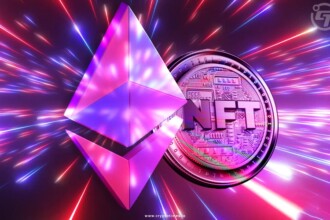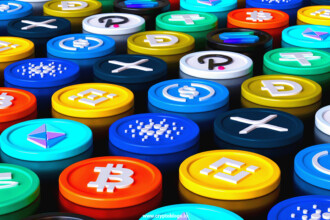In the dynamic world of blockchain technology, where innovation and progress never cease, a remarkable new development has emerged—the BRC-20 token standard. While pioneering Bitcoin blockchain revolutionized the concept of cryptocurrency, it lacked certain key functionalities that subsequent blockchains incorporated, notably the inclusion of smart contracts.
However, the ever-evolving blockchain community has persistently strived to address these shortcomings and push the boundaries of what blockchain can achieve. As a result, the recent introduction of the BRC-20 token standard marks a significant milestone in this ongoing journey of blockchain advancement.
The BRC-20 token standard not only aims to bridge the gap between Bitcoin’s pioneering success and the advanced features found in other blockchains but also opens up a world of possibilities for developers and users alike.
In this article, we will delve into the intricacies of the BRC-20 token standard, exploring what BRC-20 token is, how it works and its impact on the Bitcoin network.
What is the BRC-20 token standard?
BRC-20 is an experimental token standard on the Bitcoin blockchain network similar to Ethereum’s ERC-20 to create fungible tokens. The BRC-20 token standard was introduced by a pseudonymous on-chain analyst called Domo on March 8, 2023. The token standard enables developers to create their own tokens and transfer them via the Ordinals protocol.
Users and developers have long wanted fungible and non-fungible tokens on the Bitcoin network. Finally, BRC-20 has fulfilled one of these demands for fungible tokens.
Connection Between BRC-20 and Ordinals
The BRC-20 token standard is an innovative application of the Ordinals Protocol, introducing a novel inscription strategy. BRC-20 tokens utilize the Ordinals Protocol to imbue tagged or numbered Sats with fungibility, enabling them to function as standard tokens rather than non-fungible tokens (NFTs). So not all Ordinals are BRC-20 tokens.
Instead of creating new tokens on the Bitcoin network from scratch (which is less likely as Bitcoins have a limited supply of 21 million), the BRC-20 token standard follows the Ordinals inscription model to deploy token contracts, mint tokens, and transfer tokens.
Ordinals is the protocol designed to bring the concept of non-fungible tokens (NFTs) to the Bitcoin blockchain with different connotations. The protocol allows curators to inscribe data in images, videos, JSON, or other digital files on the smallest denomination of the Bitcoin network, Satoshi. One Satoshi is equal to one hundred millionth of a Bitcoin. Once the data is inscribed on the Satoshi, it is labeled as Ordinals inscriptions.
BRC-20 token uses Ordinals inscriptions of JavaScript Object Notation (JSON) data to deploy token contracts, mint tokens, and transfer tokens.
Hype around the BRC-20 token standard
The introduction of the BRC-20 token standard on the Bitcoin blockchain has sparked significant hype in the cryptocurrency community. This innovative standard allows developers to create, mint, and transfer new tokens, leading to a surge in market cap. At its peak, the market cap of BRC-20 tokens surpassed an impressive $1 billion at the start of May. However, as of the latest data, the market cap stands at $682,230,601, with a total of 14,307 tokens created, according to the data on brc-20.io.
The rise in the market cap can be attributed to the deployment of tokens such as ORDI, NALS, VMPX, PEPE, and MEME under the BRC-20 token standard. These tokens garnered considerable attention from investors, resulting in skyrocketing demand and a subsequent increase in market cap. This demonstrates the market’s appetite for innovation and the potential of BRC-20 tokens to drive substantial value.
While the current market cap shows a slight dip from its peak, it’s crucial to consider the cryptocurrency market’s volatility. Despite the temporary decline, the significance of the BRC-20 standard and its influence on the cryptocurrency landscape cannot be undermined.
BRC-20’s Effect on Bitcoin Blockchain Network
In contrast to straightforward peer-to-peer transactions, the creation and transfer of BRC-20 tokens are more intricate processes that demand additional blockchain space. The sheer volume of inscriptions needed for each small process has become a significant factor contributing to network congestion, leading to the recent suspension of Bitcoin withdrawals by Binance.
The accumulation of these inscriptions has overwhelmed the system, making it challenging to manage the increasing number of transactions efficiently.
Ordinals have the unique characteristic of storing all data directly on-chain. This distinction intensifies the competition for block space and can result in higher transaction fees for users aiming for quicker confirmation times.
Recently, amid BRC-20 hype, the average fee per transaction has skyrocketed, reaching over $16 and peaking at $29 on May 9. And, for the first time since 2017, the total fees per block were greater than the block reward of 6.25 BTC.
Difference Between BRC-20 or ERC-20
One of the key differences between BRC-20 and ERC-20 is the blockchain and consensus mechanism they follow. ERC-20 is based on the Ethereum blockchain and works on a proof-of-stake consensus mechanism, whereas BRC-20 tokens are based on the Bitcoin blockchain and follow a proof-of-work consensus mechanism.
Another major difference between these two tokens is their EVM compatibility. While ERC-20 tokens allow developers to create new tokens by writing a smart contract, this facility is missing in BRC-20.
BRC-20 tokens store all the data directly on-chain, so whatever image or token instructions we add to the inscription become an integral part of the transaction itself. Conversely, ERC-20 NFTs typically store a link or data that references an external service where the corresponding artwork is stored.
While ERC-20 has gained approval as a widely recognized standard, BRC-20 is still in the proposal phase. In contrast to ERC-20 tokens, which enjoy easy trading on exchanges, BRC-20 tokens currently face challenges in terms of their availability for exchange trading.
What was the First BRC-20 Token?
The first token based on the BRC-20 token standard is “ordi,” with a cap of 1,000 tokens per mint and a total supply of 21,000,000 tokens.
The emergence of ordinal wallets like Unisat led to the swift development of BRC-20 standard tools. Surprisingly, within a mere 18 hours, all 21,000,000 ordi tokens were minted, while an extra 1,500,000 ordi tokens were awaiting minting outside the established limit.
Pros and Cons of BRC-20
As more projects embrace the BRC-20 standard, it sparks innovation and opens doors to exciting use cases. Supported by a vast and diverse network user base, developers, investors, and users are drawn to its potential, fostering the continuous expansion and maturation of the BRC-20 token standard.
So if you’re asking yourself, “Is BRC-20 tokens worth investing in?” or “Is it smart to invest in BRC-20 tokens?” understanding the pros and cons of BRC-20 token standard can help.
| Advantages | Disadvantages |
| Seamless integration of Bitcoin ordinals and BRC-20 tokens to the Bitcoin blockchain | Many BRC-20 tokens lack inherent value and are often referred to as “shitcoins” |
| Easy to create, don’t need smart contracts | Users need separate wallets to store and transact with BRC-20 tokens |
| Inherent robustness of the Bitcoin blockchain with advanced security | BRC-20 tokens may face regulatory challenges |
If you want to trade crypto tokens easily, you can use a trading platform like BitQT and make a difference!
Conclusion:
The BRC-20 token standard represents a significant advancement in the world of cryptocurrency, particularly within the Bitcoin ecosystem. This experimental standard aims to push the boundaries of blockchain capabilities. Whether you are a cryptocurrency enthusiast, developer, or investor, understanding the BRC-20 token standard is essential for navigating the evolving world of blockchain technology.
From expanding Bitcoin’s utility and interoperability to fostering financial inclusion, decentralized finance, and tokenizing real-world assets, BRC-20 tokens have the potential to reshape the financial landscape.
FAQ:
1. What is the BRC-20 token?
BRC-20 token is the experimental token standard on the Bitcoin blockchain network that enables the creation of fungible tokens through the Ordinals Protocol.
2. Who created the BRC-20 token standard?
A pseudonymous on-chain analyst called Domo created the BRC-20 token standard on March 8, 2023.
3. Can I use BRC-20 tokens on Ethereum or other blockchains?
No. BRC-20 token standard is only specific to the Bitcoin network. Although other blockchains have similar token standards with different names, like ERC-20 on the Ethereum blockchain.
4. What is the BRC20 blockchain?
The BRC-20token standard is based on the Bitcoin blockchain network.
5. What are the NFT token standards?
NFT token standards define the smart contract and the features that non-fungible tokens on a particular blockchain will have. Some prominent NFT token standards are ERC-721, SPL, etc







